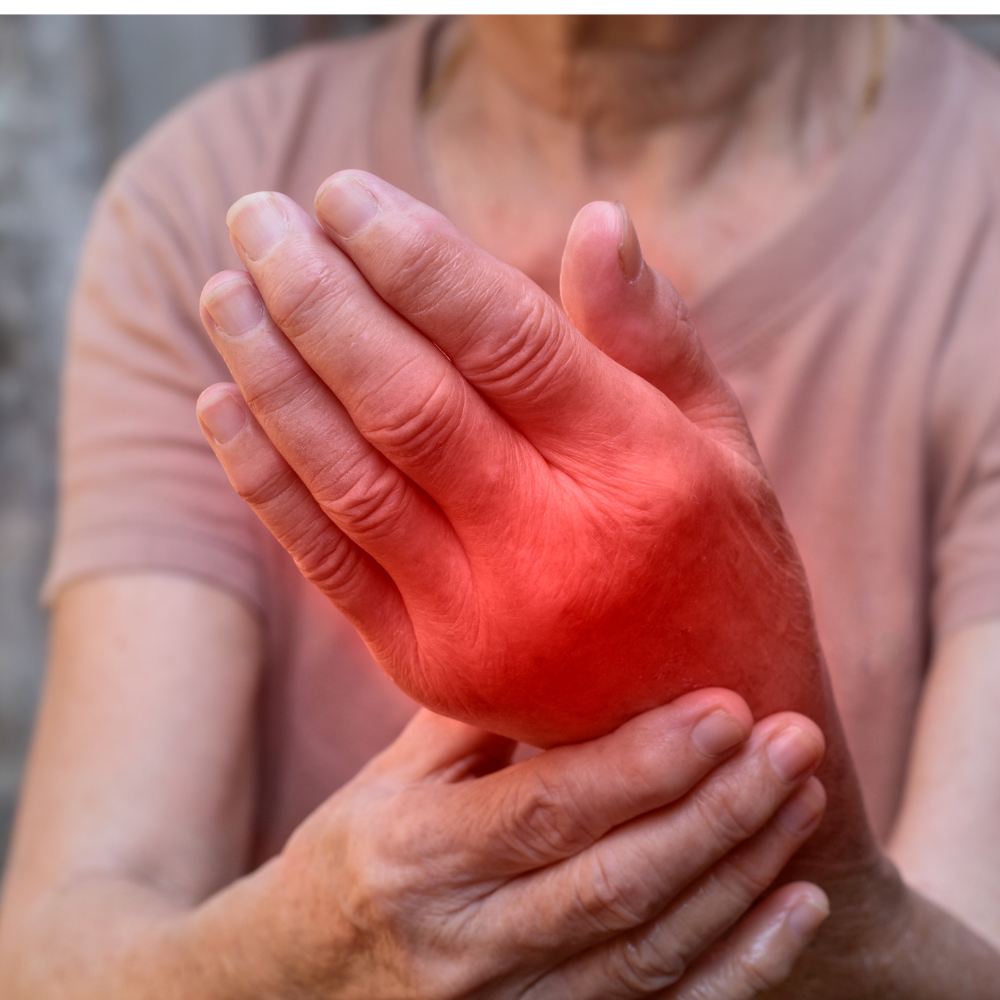Understanding and Managing Gout
Gout, a form of inflammatory arthritis, is a common and complex condition that can cause sudden and excruciating pain, swelling, and discomfort in the joints. While it most often targets the big toe joint, it can also affect other joints.
What is Gout?
Gout is a type of inflammatory arthritis activated by the accumulation of uric acid in the body. Uric acid is created when the body breaks down purines and compounds in certain foods and drinks. While it commonly affects the big toe joint, it can target other areas such as knees, ankles, feet, hands, wrists, and elbows. Symptoms occur episodically in what’s known as flares or gout attacks. Medical intervention, dietary changes, and lifestyle adjustments can help control uric acid levels and reduce the frequency of attacks.

Symptoms
Gout attacks are notorious for their sudden onset and intense pain. Typically occurring at night, these episodes can leave you awake and writhing in pain. The key symptoms include:
- Intense Joint Pain: The hallmark of a gout attack is extreme joint pain, often felt in the big toe but potentially affecting other joints such as ankles, knees, elbows, wrists, and fingers.
- Lingering Discomfort: Some discomfort may persist for days to weeks following the initial severe pain. Subsequent attacks might last longer and impact multiple joints.
- Inflammation and Redness: Affected joints become swollen, tender, warm, and visibly red.
- Limited Range of Motion: As gout advances, joints may lose their normal range of motion, further limiting mobility.
Who’s Most Vulnerable?
While it can affect anyone, certain factors increase the risk of developing the condition. Males are three times more likely to develop gout. Additionally, those with specific health conditions, such as overweight/obesity, congestive heart failure, diabetes, hypertension, kidney disease, and blood cancer, are more susceptible. Several lifestyle factors also contribute:
- Diet: Consuming high-purine foods, excessive animal proteins, alcohol consumption, and sugary drinks can elevate uric acid levels.
- Genetics: A family history of gout can increase your likelihood of experiencing the condition.
- Medications: Diuretics and immunosuppressants can impact uric acid levels.
Foods That Trigger Gout
Certain foods are notorious for causing gout flares due to their high purine content. These include:
- Sugary Drinks and Sweets: Foods rich in fructose, such as sugary drinks and sweets, can increase uric acid levels.
- High-Fructose Corn Syrup: Processed snacks containing high fructose corn syrup can raise uric acid levels.
- Alcohol: Alcohol interferes with uric acid elimination, causing it to accumulate in the body.
- Organ Meats and Game Meats: Liver, kidneys, sweetbreads, and game meats like venison and goose are high in purines.
- Certain Seafood and Red Meat: Herring, mussels, scallops, tuna, codfish, and red meats like beef, lamb, and pork can trigger gout attacks.
Diagnosis and Tests
Diagnosing gout involves a physical examination and various tests:
- Physical Exam: Healthcare providers inquire about symptoms and assess affected joints for signs.
- Imaging Tests: X-rays, ultrasounds, MRIs, and CT scans provide images of affected joints and any gout-related changes.
- Blood Tests: Measuring uric acid levels in the blood helps confirm gout.
- Joint Aspiration: A needle extracts fluid from a joint, which can be analyzed for uric acid crystals.
Strategies for Relief
Managing entails addressing acute symptoms during flares and making lifestyle changes to prevent future attacks.
- Gout Medications: Nonsteroidal anti-inflammatory drugs (NSAIDs), colchicine, and corticosteroids can alleviate pain and inflammation during attacks.
- Medications to Lower Uric Acid: Allopurinol, febuxostat, pegloticase, and probenecid are commonly prescribed to lower uric acid levels.
- Low-Purine Diet: A diet low in high-purine foods helps reduce uric acid production. Drinking plenty of water supports kidney function and hydration.
- Exercise and Lifestyle Changes: Regular exercise helps manage weight, reduce joint stress, and lower the risk of obesity-related conditions contributing to gout.
While it is not curable, it can be effectively managed with proper treatment and lifestyle adjustments. Collaborating with healthcare professionals and adhering to their recommendations can significantly reduce the frequency and severity of gout attacks.
Taking Control of Gout
Gout’s sudden and intense attacks can be debilitating, but understanding its causes, symptoms, and triggers empowers individuals to take charge of their condition. By making dietary changes, seeking medical advice, and adopting a healthier lifestyle, individuals can effectively manage and experience fewer and less severe flares. Remember, early intervention and consistent self-care can significantly impact your journey towards better joint health. If you suspect you have gout or experience sudden joint pain, don’t hesitate to consult a healthcare provider for proper diagnosis and management.







